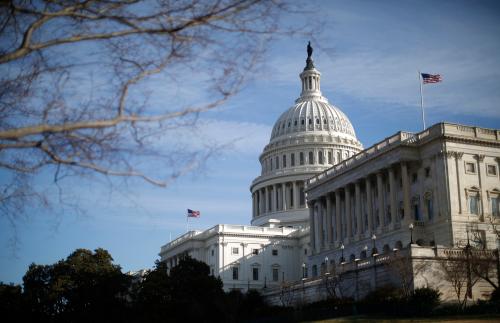The following is a testimony delivered by William G. Gale to the U.S. House of Representatives Committee on the Budget on February 27, 2019. More information about the hearing can be found here.
Chairman Yarmuth, Ranking Member Womack, and Members of the Committee:
Thank you for inviting me to testify this morning on the 2017 tax law (Public Law 115-97), commonly known as the “Tax Cuts and Jobs Act” (TCJA). The law represents the biggest tax overhaul since 1986. It has had, and will continue to have, important effects on the economy. The views presented are my own and should not be taken to represent the views of the Brookings Institution or the Urban-Brookings Tax Policy Center.
My testimony, based on my own research and that of others, focuses on several key conclusions. Although it improved the tax code in some ways, TCJA (a) will have minimal impact on long-term growth; (b) increases disparities in after-tax income by giving the largest relative and absolute tax cuts to high-income households; (c) will make most households worse off after taking into account plausible ways of financing the tax cut; (d) makes the government’s troublesome long-term fiscal status even worse; (e) makes the tax system more complex and more uncertain; (f) will make it harder for policymakers to fight future recessions; and (g) will reduce health insurance coverage, raise health insurance prices, and reduce charitable giving.
In combination, the law’s small growth impact, regressive distributional effect, and negative fiscal impact imply that TCJA made the current generation of high-income households better off at the expense of lower-income households and future generations.
For all these reasons, policymakers should revisit the tax law and address the problems associated with it, as well as turn to longer-run considerations in tax policy.
The remainder of this testimony elaborates on these conclusions and related points. I also attach several articles that I have written that document these points in more detail.
- TCJA will have minimal effects on long-term growth.
Tax cuts may raise long-term growth by improving incentives to work, save, and invest, but the deficits they create will offset some or all of those gains. Most studies indicate that the long-term impact of TCJA on Gross Domestic Product (GDP) – the output produced in the United States – will be modest. The impact on Gross National Product (GNP) – the income that Americans receive – will be even smaller. Because the TCJA will encourage foreigners to invest in the United States, the returns they receive will reduce the share of income that Americans will keep from their production. For example, the Congressional Budget Office (CBO) estimated that TCJA will raise GDP by 0.5 percent by 2028, but about 80 percent of that increase will accrue to foreigners, leaving only an increase of 0.1 percent in national income (GNP). Once depreciation is taken into account, the remaining value – net national product – is essentially unchanged. As a result, CBO estimates imply that Americans will receive no increase in net income in 2028 from TCJA as written.
- TCJA may have stimulated the economy over its first year, but other factors also clearly played an important role in recent economic performance.
Almost any tax cut will boost the economy in the short run because higher after-tax incomes increase spending and investment and, thus, overall demand for U.S. goods and services. But any boost to the economy in the short-run tells us little about the long-term effects. Indeed, the same economic models that predict that TCJA would have minimal long-term effects on growth also predict that it would have positive short-term effects. The long-term effects depend on supply-side factors, not the demand-side effects that boost short-term growth. The TCJA could spur saving and investment by increasing after-tax rates of return, but the rise in deficits created by TCJA (see below) will eventually raise the cost of capital for U.S. businesses dampen or eliminate those supply-side effects.
And it is important to recognize the role of other factors in current economic performance. First, the economy had been growing for eight straight years before TCJA was enacted, and it was expected to continue to grow steadily even in the absence of TCJA. Second, a significant amount of the economy’s recent uptick can be attributed to the higher government spending that was enacted as part of the 2018 budget deal and to recent rises in oil prices. (The U.S. used to a net importer of oil, which caused oil price increases to hurt the economy. Now, though, due primarily to “fracking,” the U.S. has become a major exporter of oil and gas, so that higher prices encourage U.S. investment through increased rig construction and drilling activity.)
Thus, it is not evident that TCJA has had big effects in the short-term and, even if it did, that result is not indicative of the long-term results.
- TCJA is providing disproportionately large benefits to high-income households.
TCJA gave most of its benefits to the wealthy and thus increased the inequality of income, which had already been growing for the past four decades. Tax Policy Center (TPC) estimates show that TCJA increased after-tax income in 2018 by 0.4 percent for households in the lowest quintile, compared with 2.9 percent for those in the top quintile, and even more for the top few percent of households.
- Taking into account plausible methods of financing the tax cut, most households will end up worse off under TCJA than if it had not been enacted.
About 80 percent of taxpayers received a direct tax cut from TCJA, but that is not the end of the story. Tax cuts eventually have to be paid for. When President Trump said he was giving Americans a tax cut for Christmas, for example, he neglected to add that they (or their children) eventually would receive the bill. It is unclear how TCJA will eventually be financed, but in the most likely scenarios – where tax increases or spending cuts are imposed very broadly – for example, on an equal-per-household basis or and equal-share-of-income basis – most households will end up worse off than had the TCJA never passed.
- TCJA makes a troublesome federal fiscal situation even worse.
At the risk of stating the obvious, TCJA reduces revenues. It does not pay for itself. It does not come close to paying for itself. Revenues fell by 0.8 percent in 2018, even though the economy was growing. Corporate revenues plummeted.
The CBO estimates that TCJA will increase deficits by almost $1.9 trillion through 2028, even after incorporating the positive impact of the new law on the economy. If lawmakers make the temporary provisions of TCJA permanent, the long-term effects will be even more dire.
The Congressional Budget Office and my own research with Alan Auerbach and Aaron Krupkin show that the nation was poised for persistent and rising federal budget deficits and government debt even before TCJA was enacted. TCJA exacerbated this problem.
- The combination of the minimal growth impact, the regressive distributional impact, and the negative fiscal impact, all described above, imply that TCJA will redistribute resources to current high-income households at the expense of current lower-income households and future generations.
- Although the tax law simplified taxes in some ways, it also made the tax system more complex in significant ways and created significant uncertainty surrounding tax policy.
The chief sources of increased complexity are the pass-through provisions (section 199A) and the rules regarding international transactions and income (GILTI, BEAT, and FDII). The pass-through provisions are notoriously complex and often seem arbitrary in how they define qualifying businesses. The international rules are enormously complex and create unintended interactions, which cause effective tax rates to vary widely across investments.
The increased complexity has boosted employment significantly at law and accounting firms that provide tax advice.
Some of the uncertainty and complexity arises because the legislation was poorly drafted. These complexities are due in part to the rushed manner in which Republican majorities pushed TCJA through the Congress. The combination of new, complicated tax changes and a rushed legislative calendar is a predictable recipe for disaster.
TCJA raised uncertainty in several ways. First, the interpretation of many of the rules – particularly for international taxation – is still not clear. Second, almost all the individual income tax provisions expire by the end of 2025, even though TCJA advocates insist that they will be extended. Other nonstandard items – such as the phase-in of amortization for R&D and increases in the so-called GILTI tax – raise questions as to whether they will be enacted. All these factors suggest that revisiting the law in the near future would be timely.
- The 2017 tax law will make it harder for policymakers to fight recessions.
The U.S. tax system generally works to help stabilize the economy. Tax revenues tend to rise and fall by more than income does, serving as an automatic stabilizer that buffers recessions and moderates booms. The 2017 tax law reduces the ability of the tax system to serve as an automatic stabilizer. The chief culprits are reductions in marginal personal and corporate income tax rates, changes to rules regarding net operating losses, and changes to deductions for depreciation and interest. The cyclical properties of FDII will exacerbate these problems.
Congress passed the TCJA at a time when the United States had recovered from the Great Recession. Tax cuts are most useful when they stimulate the economy during times of recession. At a time of full employment and strong corporate profits, however, Congress should have increased taxes to address the long-term fiscal shortfall, not cut them.
- The 2017 tax law will raise the cost of health insurance and reduce coverage and will likely reduce charitable contributions.
By eliminating the tax on people who do not buy adequate health insurance, TCJA will reduce health insurance coverage and raise health insurance premiums. This happens because, without a penalty, healthy people are most likely to forgo health insurance, knowing that ACA guarantees access to insurance in the future if their health status deteriorates. The law’s reductions in alcohol excise taxes, if they are passed through to consumers, will raise alcohol-related deaths and other costs.
The sharp reduction in the number of households who will be able to itemize deductions on their income tax will likely reduce charitable contributions, as will the reduction in the top individual and corporate tax rates.
- It is time to revisit and reform the 2017 tax law and move on to additional matters in tax revenues.
The section 199A provisions are clearly inequitable, complex, regressive, and arbitrary. By taxing certain forms of business income lower than other forms of business income and by taxing business income at lower rates than wage income, the rules create all sorts of wasteful incentives for tax sheltering. These provisions should be repealed (or let to expire).
This can and should be considered jointly with efforts to broaden the tax base and raise rates for high-income households, including taxing capital gains at death (or providing a carry over basis regime).
The international rules’ complexity and unintended effects calls for a revisiting and revamping of the law.
The sheer regressivity of the estate tax changes calls for reconsideration of those changes as well as consideration to move to an inheritance tax, to tax capital gains at death and/or consider some form of wealth taxation.
There is no substitute for giving the IRS the additional resources, people, tools, and legal changes that it needs to help track down at least some of the more than $500 billion tax gap the country faces today. These are taxes that are owed but not paid. We have good data on where the evasion takes place – capital income in general and sole proprietorship income in particular, and various studies show that each dollar of spending on enforcement can raise $3-$4 or more in revenues, yet the IRS budget is tiny, its work force is shrinking, and audit rates are down. This situation needs to be corrected immediately and permanently.
Looking to longer-term revenue needs, the nation will clearly need more revenue in the future to address rising health care and social security costs, rising net interest costs, and the debt (even if judicious cuts to non-interest spending are made). The obvious candidates here would be to let the TCJA rate cuts and brackets expire, to enact a value-added-tax (on the order of 10 percent, with offsets for low-income household) or to enact a significant carbon tax (starting at $30-$40 per ton, rising with inflation, and with offsets for low-income households.).
Thank you again for inviting me. I look forward to addressing these issues with you.









Commentary
TestimonyTestimony on the 2017 tax law: Impact on the budget and American families
February 28, 2019